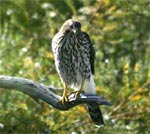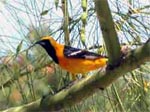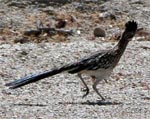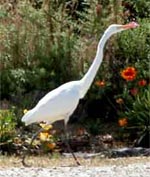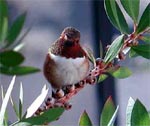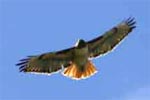| Bird-Watching on the Road, by Alice Zyetz |
|
<First
Page Page
1 |
2
|
|
BIRD-WATCHING RESOURCES
10000birds.com has a list of the top 25 National Wildlife Refuges for birding. For additional locations, click here. Another general site is www.birdwatching.com. BirdWatchingHQ is based in Ohio and includes Live Bird web cams in several places around the globe and an active blog. (Updated December 23, 2020)
PHOTOGRAPHING BIRDS
Many of us use digital cameras now, making it harder to catch the birds in flight. A long lens is preferable as well a rapid response between shots. Thank you to Carl for sharing some of his photos of birds that are generally common to the southern and western states: common raven, Cooper's hawk, double-crested cormorant, great blue heron, great egret, greater roadrunner, hooded oriole, red-tailed hawk, rufous hummingbird, and white-crowned sparrow.
HOW TO GET STARTED
The three main requirements to get started are
1) a pair of good walking shoes; 2) a good guidebook (the
Ericksons recommend
National Geographic Field Guide To The Birds Of North America;
3)
A good pair of binoculars (8x20 or 10x30).
The most important rule when bird-watching is to talk softly
and not too much. Then you can listen for their movement as
well as their calls.
HOW TO RECOGNIZE BIRDS
The Ericksons suggest that you learn how birds look in detail. Generally start from the head downward. Look at the back, the breast, and the tail. Use your book to help you. Learn the songs and calls. For example, the great horned owls don't just hoot, and the males' calls are deeper than those of the females. I was unusually lucky one time on a Texas beach. My goal was to identify different types of gulls. One sat down next to me, but the orientation in the book was different. I silently pleaded with the bird to change his position. He did, and then looked exactly the same as the gull in the book. That doesn't happen very often.
Another suggestion is to go on leader-sponsored bird walks. The day before, look at the regional birds in your bird book so you have some idea of what to expect. Another resource is a telephone hotline of recent sightings of particular birds in the area. After a while, you'll begin to be aware of what birds you've seen before.
Carl and Ann say that their interest in birds changed their philosophy of life. "We now value all forms of life and recognize the importance of a healthy environment."
Add birding to your travels. All you need is a book, a pair of binoculars, and a good pair of shoes. And don't forget an alarm clock!
Alice Zyetz
1/29/06
(Links updated 12/23/20, RTA)
Page 1|2

